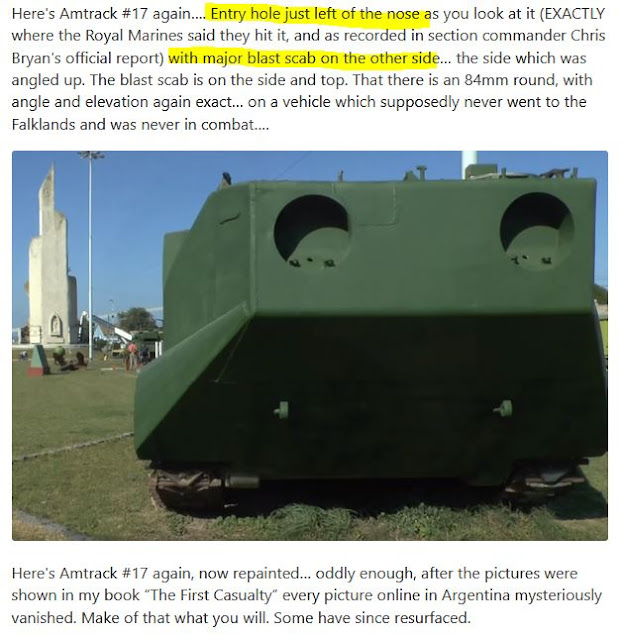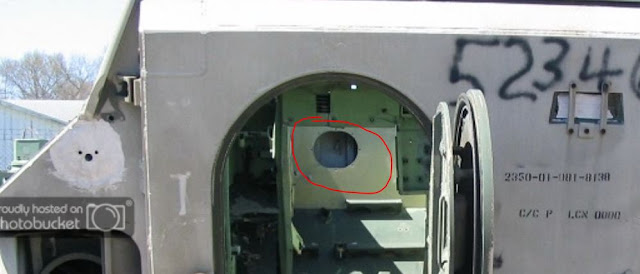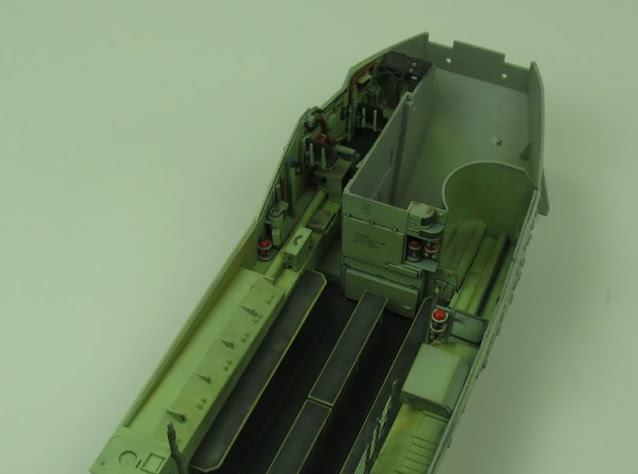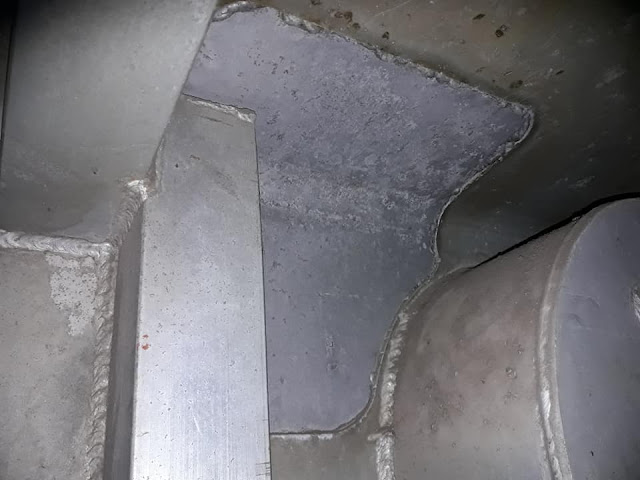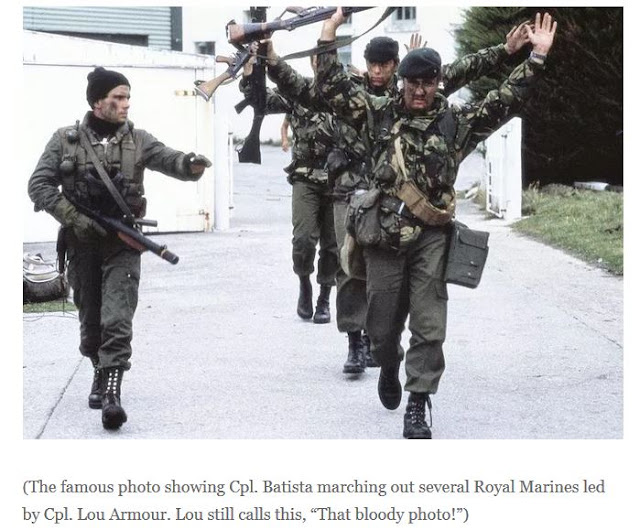LVTP-7: Nose Patch
More pictures and videos showing that the internal damage is not compatible with Phillips theory, the impossibility to affect the crew compartment even accepting the damage was caused by a HEAT impact, and pictures of the vehicle from 1986-87 showing no damage in that area.
Nose impacts
And finally, the patches in the nose.
Let’s see RDP’s description:
Click on pictures to enlarge
A closer look
Now let’s take a closer look, thanks to my friends
in Quequén:
The nose patch, right next to the lights cavity,
looks like that section was cut and replaced with a new chunk.
An inside look
When you look inside the VAO, the nose section
has a bulkhead that separates it from the engine compartment, you need to look
through a maintenance panel:
These hobbyist model show the approximate internal disposition of the
vehicle, even if a rocket penetrated the hull in the proposed direction, it’s
clear that the crew compartment would be perfectly safe:
In this report, "Marine Corps Assault Amphibious Vehicle Survivability Upgrade" of the Inspector General U.S. Department of Defense, (Report No. DODIG-2018-060, Page 10), we can confirm the internal disposition of the internals, showing the troop compartment, power pack section, and the flotation cavity in the nose:
In this report, "Marine Corps Assault Amphibious Vehicle Survivability Upgrade" of the Inspector General U.S. Department of Defense, (Report No. DODIG-2018-060, Page 10), we can confirm the internal disposition of the internals, showing the troop compartment, power pack section, and the flotation cavity in the nose:
This is the nose patch from the inside, you
can see the front lights cavity right beside it:
The patch and the surroundings look pristine,
apart from some welding droplets over the lights cavity, and some dirt. What
about the side patch, where the “major blast scab” occurred?
It certainly looks like a penetration, but the lack of spalling/pitting damage in the surroundings, no burnt or melted surface of the hole itself and the bent aluminum sheet suggest a low velocity blunt force impact with another rigid object, maybe another vehicle or the Cabo San Antonio’s ramp when reembarking from the water. The bulkhead right behind it also looks undamaged, so whatever happened, it didn’t compromise the crew section either. Here’s a video of VAO 17 nose internals:
In summary, even if the vehicle went to combat
and got hit three times, it’s pretty conclusive to say none of those hits
penetrated the crew compartment, hence no casualties inside.
Post war pictures
As a side note, this vehicle was seen after
the war in The Falklands War -The Untold Story documentary released in 1987, during
an interview with Cpl. Jacinto Batista, protagonist of the most famous picture
of the Argentine landing:
If we compare it with this present picture of
VAO 17, the side patch should have been visible from that angle, right above the ID number, so it’s not
unthinkable to say that those patches were applied some time after this
interview:The real cause of the Nose Patches on VAO 17
Zona Militar
is the most important military forum in Argentina, where many veterans,
researchers and personnel in service of Argentine military share their
knowledge with enthusiasts from al Latin America. I've published in
Spanish most of my findings in this thread, and a few days ago I was surprised that an Argentine Navy officer that was in charge of the Amtrack Battallion stated the real cause of the damage on VAO 17's nose. This officer is Retired Ship Captain of Marine Infantry Armando Vittorangelli, and he commented about this picture published by Ricky Phillips in his Twitter account. Here's his account:
"I was VAO Company Chief for 3 years, Second Commander of the Amphibious Vehicle Battalion for 2 years, Commander for one year and Head of the Project that repowered them for 8 years. In fact, I had to have VAO 17 prepared and sent to Necochea when I was Second Commander. That vehicle did not go to Malvinas [Falklands]. The weld marks seen on the bow, where it says Patch, are repairs for holes that were made when hitting against the BDT San Antonio bow door and that damaged the bow buoyant, during maneuvers to enter through the ramp at sea. These entries were difficult and dangerous, especially when there was a lateral current component towards the bow (when anchored with bow anchor), or the ship anchored with elbow anchor (stern) swinging very strongly. Several hulls have it. Where it says No Sight, goes the episcope of the Embarked Scoutmaster, the vehicle went with it [to Quequén Monument], today it must be part of the collection of some thief who took it out of the vehicle (it is very easy to remove). The vehicle hit in Malvinas [Falklands] was the 07, which received 107 (if I remember correctly) 7.62 mm impacts, but none pierced the hull. Regarding the fire on the vehicles on April 2, none were hit by anti-tank weapons, confirmed in the conference given by CN Santillan on April 7 at the Argentine Defense Forum. In fact the part that is shown in the photo [the light cluster] I don't know what it is, but it is not from an LVTP7, because that part is made of steel and the vehicle is made of aluminum. What he [Phillips] says about the amphibious vehicle is pure fantasy.
Neither do I [remember when the collision happened], but it was common, almost everyone had hit it at some point. I think that in 17 one was when I was Head of the Company"
A collision with ARA Cabo San Antonio's ramp was the main hypothesis to explain the patch, but it seems that it was actually one of the bow doors. Vittorangelli's deposition brings a confirmation that VAO 17's damage is not the product of a hit during combat, but the result of the complicated maneuver to embark through that narrow ramp during an exercise.
Next: TFC Bibliography
